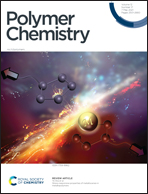Poly[glycidyl oligo(oxyethylene)carbamate]s (PGn-EOmR′ and R-PGn-EOmR′): controlled synthesis and effects of molecular parameters (n and m), side groups (R′), and end-groups (R) on thermoresponsive properties†
Abstract
The controlled syntheses of glycerol-based polymers, involving poly(glycidol) (PG)-backbones and thermoresponsive oligo(oxyethylene)-side chains, are described. The organocatalytic ring-opening polymerizations of benzyl glycidyl ether (BnGE) were performed to produce poly(benzyl glycidyl ether)s (PBnGEns) in which the degree of polymerization (n) was predetermined, followed by the removal of the inherent protection groups. For these polymerization/deprotection stages, the synthesis of two major types of polymers is emphasized, in which one is “pristine” PG without any specific end-groups (PGn) and the other is the α-end functionalized PG with hydrophobic aliphatic and aromatic groups (R-PGn). The post-modification reactions based on the addition reactions of isocyanate derivatives to the hydroxyl side groups were adopted for PGn and R-PGn, thus producing poly[glycidyl oligo(oxyethylene)carbamate]s with diverse structures. The structures can generally be expressed as PGn-EOmR′ and R-PGn-EOmR′, where (i) the degree of polymerization (n), (ii) the alkyl group at the periphery of the side groups (R′), (iii) the number of oxyethylene chains (m), and (iv) the α-end group (R) can be independently controlled and/or selected. The effects of the parameters/structures (i)–(iv) on the thermoresponsive properties and the supporting data for the phase transitions in aqueous media are described in detail.
![Graphical abstract: Poly[glycidyl oligo(oxyethylene)carbamate]s (PGn-EOmR′ and R-PGn-EOmR′): controlled synthesis and effects of molecular parameters (n and m), side groups (R′), and end-groups (R) on thermoresponsive properties](/en/Image/Get?imageInfo.ImageType=GA&imageInfo.ImageIdentifier.ManuscriptID=D1PY00070E&imageInfo.ImageIdentifier.Year=2021)


 Please wait while we load your content...
Please wait while we load your content...